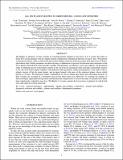| dc.contributor.author | Lissauer, Jack J. | |
| dc.contributor.author | Jontof-Hutter, Daniel | |
| dc.contributor.author | Rowe, Jason F. | |
| dc.contributor.author | Fabrycky, Daniel C. | |
| dc.contributor.author | Lopez, Eric D. | |
| dc.contributor.author | Agol, Eric | |
| dc.contributor.author | Marcy, Geoffrey W. | |
| dc.contributor.author | Deck, Katherine M. | |
| dc.contributor.author | Fischer, Debra A. | |
| dc.contributor.author | Fortney, Jonathan J. | |
| dc.contributor.author | Howell, Steve B. | |
| dc.contributor.author | Isaacson, Howard | |
| dc.contributor.author | Jenkins, Jon M. | |
| dc.contributor.author | Kolbl, Rea | |
| dc.contributor.author | Sasselov, Dimitar | |
| dc.contributor.author | Short, Donald R. | |
| dc.contributor.author | Welsh, William F. | |
| dc.date.accessioned | 2015-02-06T19:59:06Z | |
| dc.date.available | 2015-02-06T19:59:06Z | |
| dc.date.issued | 2013-06 | |
| dc.date.submitted | 2013-02 | |
| dc.identifier.issn | 0004-637X | |
| dc.identifier.issn | 1538-4357 | |
| dc.identifier.uri | http://hdl.handle.net/1721.1/93914 | |
| dc.description.abstract | The Kepler-11 planetary system contains six transiting planets ranging in size from 1.8 to 4.2 times the radius of Earth. Five of these planets orbit in a tightly packed configuration with periods between 10 and 47 days. We perform a dynamical analysis of the system based upon transit timing variations observed in more than three years of Kepler photometric data. Stellar parameters are derived using a combination of spectral classification and constraints on the star's density derived from transit profiles together with planetary eccentricity vectors provided by our dynamical study. Combining masses of the planets relative to the star from our dynamical study and radii of the planets relative to the star from transit depths together with deduced stellar properties yields measurements of the radii of all six planets, masses of the five inner planets, and an upper bound to the mass of the outermost planet, whose orbital period is 118 days. We find mass-radius combinations for all six planets that imply that substantial fractions of their volumes are occupied by constituents that are less dense than rock. Moreover, we examine the stability of these envelopes against photoevaporation and find that the compositions of at least the inner two planets have likely been significantly sculpted by mass loss. The Kepler-11 system contains the lowest mass exoplanets for which both mass and radius have been measured. | en_US |
| dc.description.sponsorship | United States. National Aeronautics and Space Administration (Kepler Participating Scientist Program, NASA grant NNX12AD23G) | en_US |
| dc.description.sponsorship | National Science Foundation (U.S.) (grant AST-1109928) | en_US |
| dc.description.sponsorship | National Science Foundation (U.S.) (NSF Career grant AST-0645416) | en_US |
| dc.description.sponsorship | United States. National Aeronautics and Space Administration (NASA Science Mission Directorate) | en_US |
| dc.description.sponsorship | United States. National Aeronautics and Space Administration (Fellowship, NASA Postdoctoral Program) | en_US |
| dc.language.iso | en_US | |
| dc.publisher | Institute of Physics/American Astronomical Society | en_US |
| dc.relation.isversionof | http://dx.doi.org/10.1088/0004-637x/770/2/131 | en_US |
| dc.rights | Article is made available in accordance with the publisher's policy and may be subject to US copyright law. Please refer to the publisher's site for terms of use. | en_US |
| dc.source | American Astronomical Society | en_US |
| dc.title | ALL SIX PLANETS KNOWN TO ORBIT KEPLER-11 HAVE LOW DENSITIES | en_US |
| dc.type | Article | en_US |
| dc.identifier.citation | Lissauer, Jack J., Daniel Jontof-Hutter, Jason F. Rowe, Daniel C. Fabrycky, Eric D. Lopez, Eric Agol, Geoffrey W. Marcy, et al. “ALL SIX PLANETS KNOWN TO ORBIT KEPLER-11 HAVE LOW DENSITIES.” The Astrophysical Journal 770, no. 2 (June 4, 2013): 131. © 2013 American Astronomical Society. | en_US |
| dc.contributor.department | Massachusetts Institute of Technology. Department of Physics | en_US |
| dc.contributor.department | MIT Kavli Institute for Astrophysics and Space Research | en_US |
| dc.contributor.mitauthor | Deck, Katherine M. | en_US |
| dc.relation.journal | Astrophysical Journal | en_US |
| dc.eprint.version | Final published version | en_US |
| dc.type.uri | http://purl.org/eprint/type/JournalArticle | en_US |
| eprint.status | http://purl.org/eprint/status/PeerReviewed | en_US |
| dspace.orderedauthors | Lissauer, Jack J.; Jontof-Hutter, Daniel; Rowe, Jason F.; Fabrycky, Daniel C.; Lopez, Eric D.; Agol, Eric; Marcy, Geoffrey W.; Deck, Katherine M.; Fischer, Debra A.; Fortney, Jonathan J.; Howell, Steve B.; Isaacson, Howard; Jenkins, Jon M.; Kolbl, Rea; Sasselov, Dimitar; Short, Donald R.; Welsh, William F. | en_US |
| mit.license | PUBLISHER_POLICY | en_US |
| mit.metadata.status | Complete | |
